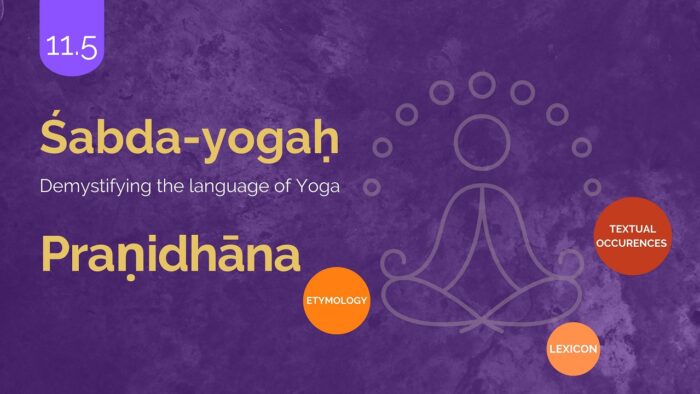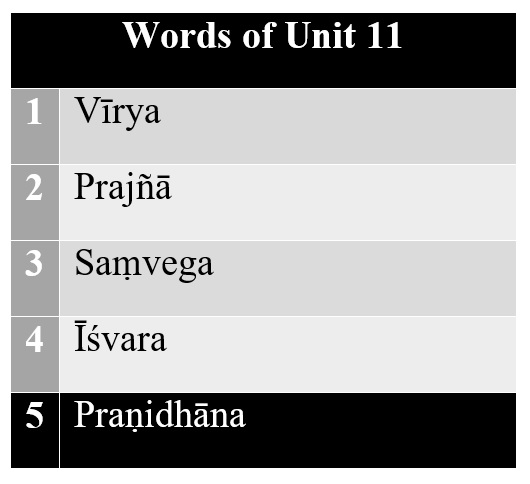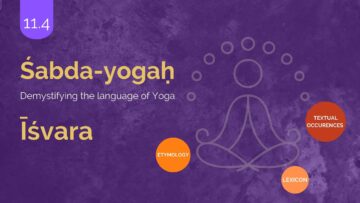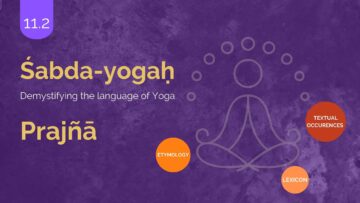Introduction
In this series, Yogic terminologies will be taken up and their –
- Etymological analysis,
- Lexical descriptions and
- Textual occurrences in Yogic literature and their commentaries, as available, will be presented. And finally observations will be made on the references.
Three texts – Yogasūtra, Haṭha-yoga-pradīpikā and Bhagavad-gītā are consulted for textual occurrences portion.
Śabda-yoga is intended to help students, teachers, and professionals of Yoga to develop a sound grammatical, contextual, and thereby an authentic and immersive understanding of Yoga terminologies.
List of Words
We will take up important Yogic terms from Sūtra-s 1.20 – 23. The terms that will be analyzed in this Unit are –
Etymology
प्र + नि + धा + ल्युट् = प्रणिधानम्
pra + ni + dhā + lyuṭ = praṇidhānam
- The Prefixes here are pra and ni – that means respectively. Pra refers to प्रकर्ष – prakarṣa- clearly/explicitly[1]ni – नितराम् – nitarām completely[2]
- The root is dhāto mean – धारण-पोषणयोःdhāraṇa-poṣaṇayoḥ- to hold and to nourish
- The suffx is lyut which is added by the grammatical ruleल्युट्चlyuṭ ca (aṣṭādhyāyī3.115) . The meaning brought in by adding the suffix is the – भाव – the act.
Hence the derivation of the term would be – प्रणिधीयतेइतिप्रणिधनम् –praṇidhīyateitipraṇidhanam- the act of placing clearly and completely/ surrendering.
Lexicon
There is one reference to the word in amarakośa. It is as follows –
अवधानंसमाधानंप्रणिधानंतथैवच – 1.5.2
avadhānaṃsamādhānaṃpraṇidhānaṃtathaiva ca
avadhāna, samādhāna and praṇidhāna are used to indicate the meaning fixing the mind.
(It is to be noted that this verse is not found in certain versions of Amarakośa. The source of this reference is Amaraaupasana[3])
Textual Occurrences
Yogasūtra
There are four occurences of the term in this text. Once in the first pāda and thrice in second pāda of the text. These sūtras have all been explained as part of the previous entry – īśvara (śabdayoga 11.4).
ईश्वरप्रणिधानाद्वा॥१.२३॥
तपःस्वाध्यायेश्वरप्रणिधानानिक्रियायोगः॥२.१॥
शौचसंतोषतपःस्वाध्यायेश्वरप्रणिधानानिनियमाः॥२.३२॥
समाधिसिद्विरीश्वरप्रणिधानात्॥२.४५॥
īśvarapraṇidhānādvā .. 1.23 ..
tapaḥsvādhyāyeśvarapraṇidhānānikriyāyogaḥ .. 2.1 ..
śaucasaṃtoṣatapaḥsvādhyāyeśvarapraṇidhānāniniyamāḥ .. 2.32 ..
samādhisidvirīśvarapraṇidhānāt .. 2.45 ..
But it is interesting to note the meaning of the word Praṇidhāna given in the Yogasūtra commentaries. The following are unique descriptions to the word Praṇidhāna (Sūtra 1.30) – found in the commentaries –
1) Vyāsa- bhāṣyam – प्रणिधानाद् – भक्तिविशेषात् – – praṇidhānād – bhaktiviśeṣāt – It is special devotion
2) Bhoja-vṛtti– विषयसुखादिकंफलमनिच्छन्सर्वाःक्रियास्तस्मिन्परमगुरावर्पयतितत्प्रणिधानम् – – viṣayasukhādikaṃphalamanicchansarvāḥkriyāstasminparamagurāvarpayati tat praṇidhānam – Not desiring results, surrendering all actions in the ultimate Guru is called as Praṇidhānam
3) Yoga-vārttika– ब्रह्मात्मनाचिन्तरूपतयाप्रेमलक्षणभक्तिरूपाद् (प्रणिधानाद्)
– brahmātmanācintarūpatayāpremalakṣaṇabhaktirūpād (praṇidhānād ) – Meditating upon oneself as the Brahman and also being endowed with the devotion in the form of love (for the divinity)
4) Bhāsvatī– सर्वकर्मापणपूर्वंभावनारूपंप्रणिधानंनतुकर्मार्पणमात्रम्
– sarvakarmāpaṇapūrvaṃbhāvanārūpaṃpraṇidhānaṃnatukarmārpaṇamātram
It is in the form of surrendering all actions and also meditating (upon the divinity) and not mere surrendering of actions
5) Yoga-siddhānta-candrikā– प्रणिधीयतेतदेकमात्रनिष्ठंमनःक्रियतेऽनेनेतिपुनःपुनारूपंप्रेमतत्साधनमन्त्रजपाराध्यत्वज्ञानादिरूपाद्वक्ष्यमाणाद्भक्तियोगाद्–- praṇidhīyatetadekamātraniṣṭhaṃmanaḥkriyate’nenetipunaḥpunārūpaṃprematatsādhanamantrajapārādhyatvajñānādirūpādvakṣyamāṇādbhaktiyogād -Praṇidhāna refers to making the mind single-pointed by again and again doing various practices that are instrumental to that end – in the form of japa of the mantras, worshipping etc
6) Nāgojī-bhaṭṭa-vṛtti– प्रणिधानं’तज्जपस्तदर्थभावनम्’इतिवक्ष्यमाणम्
nāgojībhaṭṭavṛttiḥ – praṇidhānaṃ ’tajjapastadarthabhāvanam’ itivakṣyamāṇam – Praṇidhāna is stated as – “repeating (the Praṇava) and visualizing its meaning”.
7) Yogavallī – अहरहःप्रणिपतनमेवप्रणिधानशब्दार्थः – aharahaḥpraṇipatanamevapraṇidhānaśabdārthaḥ – Every day saluting/prostrating (to the divinity) is the meaning of the word Praṇidhāna.
Thus the commentaries give a range of mutually inclusive meanings towards facilitating the practice of Praṇidhāna of īśvara. This is an indicative collection of the meaning of the term Praṇidhāna on just one occurrence of the term in the Sūtra 1.30. The commentary literature may offer many meanings of the term in the other occurrences of Praṇidhāna in the other three Sūtras. For fear of being elaborate – just meanings of one occurrence also has been discussed.
Bhagavadgītā
There is just one occurence of a related term to Praṇidhāna in this text. It is as follows –
तस्मात्प्रणम्यप्रणिधायकायंप्रसादयेत्वामहमीशमीड्यम् ।
पितेवपुत्रस्यसखेवसख्युःप्रियःप्रियायार्हसिदेवसोढुम्॥11. 44॥
tasmātpraṇamyapraṇidhāyakāyaṃprasādayetvāmahamīśamīḍyam .
pitevaputrasyasakhevasakhyuḥpriyaḥpriyāyārhasi deva soḍhum .. 11. 44 ..
This verse occurs in the 11th chapter Viśvarūpa-darśana – where Arjuna sees the cosmic form of ŚrīKṛṣṇa. One being astonished and awe inspired by the cosmic form – Arjuna states – I salute and lay my body down (in prostration) and please you. Here – praṇidhāya- lay the body down – in prostration –is used.
Haṭha-yoga-pradīpikā–There are no usages of the term in this text.
Tabulation of Textual References 11.5 
Summary and Observations
It could be observed that the word Praṇidhāna is a unique expression found in the Yogasūtras.
But it should be noted that though Bhagavadgītā does not use the word Praṇidhāna – the word Bhakti is profusely used and an entire chapter (chapter 12) is devoted to Bhakti yoga which indicated by the term Praṇidhāna.
And interestingly in Haṭhayoga neither has any major discussion or practice based on Praṇidhāna or Bhakti – indicating its focus more on the practices related to the body, breath. In Haṭhayoga even in the realm of the mind – more than the emotional dimension of human psyche (Bhakti)- the focus is more on training the mind to be fixed and focused on the various cakras and the Nāda.
In the Yogasūtra – as could be seen above – based on the views of the commentators’ approaches to the practice of Praṇidhāna can be enumerated as follows for easy comprehension–
1) Praṇidhāna is devotion.
2) It involves surrendering all actions to the supreme guru.
3) It involves relinquishing desire for the results of actions.
4) It is in the form of love – prema – on the supreme being.
5) It includes physically prostrating to the divinity.
6) It is in the form of repetition of Praṇava and meditating upon its meaning.
7) It also includes the worship of the divinity.
8) In the process of expression of devotion – the fixing or focusing of the mind on the divinity is essential.
9) Praṇidhāna is not a onetime action – it involves repetition of expression of devotion.
10) Praṇidhāna culminates in visualizing of oneself as the Brahman.
Thus these are the ideas and insights that could be gained by analyzing the term Praṇidhāna following the Śabdayoga methodology.
[1]Avyayakosha: https://archive.org/details/avyaya-kosa-srivatsankacharya/page/258/mode/2up?view=theater
[2]https://archive.org/details/avyaya-kosa-srivatsankacharya/page/226/mode/2up?view=theater
[3]http://amara.aupasana.com/sloka?sloka_number=1.5.2
Links for previous posts in this unit
Disclaimer: The opinions expressed in this article belong to the author. Indic Today is neither responsible nor liable for the accuracy, completeness, suitability, or validity of any information in the article.











